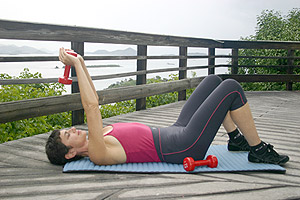 Loading... Please wait...
Loading... Please wait...- Home
- COACH
- Moving Free™
- SHOP
- CLUB
- ART
- FABULOSITY®
- BIO
- CONSULT
- AMAZON
-
Live Long
- Diet & Nutrition
- Easy Exercise Videos Mirabai Holland
- Fitness Longevity
- Fabulous Forever After 50 Mirabai Holland
- Senior Exercise Videos Mirabai Holland
- Baby Boomer Exercise Mirabai Holland
- Beginner Exercise Videos Mirabai Holland
- Moving Free
- Weight Loss
- Cardio
- Strength
- Flexibility
- Body Type
- Stress Reduction
- Medical Care
-
Health
- Exercise and Memory Issues
- Chronic Stress: How To Get Rid Of It
- Exercise & Heart Disease
- Exercise & Diabetes
- Exercise & Autoimmune Diseases
- Osteoporosis
- Exercise for Arthritis
- Back Pain
- Exercise & Orthopedic Issues
- Coping With Cancer
- Pulmonary Asthma
- Exercise And Parkinson's Disease
- Perimenopause & Menopause
- Exercise & Depression
- Sleep Better with Exercise
- BLOG
- Contact
Categories
Our Newsletter
Exercise & Heart Disease

Aerobic exercise is also called CARDIO because it strengthens and protects your whole cardiovascular system from Coronary Heart Disease. Do some easy aerobics. In fact, just a half hour of moderate aerobic exercise daily can reduce heart attack risk by 50%. It’s also known that strength training 2-3 times a week is effective. Here are some videos that address this issue. Click each picture below to learn about each.






Heart Disease is the Number 1 killer of women in the United States.
 According to the American Heart Association, "Nearly twice as many women in the United States die of heart disease and stroke as from all forms of cancer, including breast cancer." A new campaign to promote awareness of heart disease among women is underway. Long considered a higher risk for men, heart disease in women was not as well studied. However, with overweight and obesity a growing problem for all Americans, women are encouraged to avoid the risk factors for heart disease, including eating a healthful, plant-based diet and getting plenty of regular exercise throughout their lives.
According to the American Heart Association, "Nearly twice as many women in the United States die of heart disease and stroke as from all forms of cancer, including breast cancer." A new campaign to promote awareness of heart disease among women is underway. Long considered a higher risk for men, heart disease in women was not as well studied. However, with overweight and obesity a growing problem for all Americans, women are encouraged to avoid the risk factors for heart disease, including eating a healthful, plant-based diet and getting plenty of regular exercise throughout their lives.
It is also important to know the warning signs of heart disease. The American Heart Association says, “Heart attack and stroke are life-and-death emergencies -- every second counts. If you see or have any of the listed symptoms, immediately call 9-1-1. Not all these signs occur in every heart attack or stroke. Sometimes they go away and return. If some occur, get help fast!
Heart Attack Warning Signs
Some heart attacks are sudden and intense — the "movie heart attack," where no one doubts what's happening. But most heart attacks start slowly, with mild pain or discomfort. Often people affected aren't sure what's wrong and wait too long before getting help. Here are signs that can mean a heart attack is happening:
 Chest discomfort. Most heart attacks involve discomfort in the center of the chest that lasts more than a few minutes, or that goes away and comes back. It can feel like uncomfortable pressure, squeezing, fullness or pain.
Chest discomfort. Most heart attacks involve discomfort in the center of the chest that lasts more than a few minutes, or that goes away and comes back. It can feel like uncomfortable pressure, squeezing, fullness or pain.- Discomfort in other areas of the upper body. Symptoms can include pain or discomfort in one or both arms, the back, neck, jaw or stomach.
- Shortness of breath. May occur with or without chest discomfort.
- Other signs: These may include breaking out in a cold sweat, nausea or lightheadedness.
As with men, women's most common heart attack symptom is chest pain or discomfort. But women are somewhat more likely than men to experience some of the other common symptoms, particularly shortness of breath, nausea/vomiting, and back or jaw pain.
The American Stroke Association says these are the warning signs of stroke:
- Sudden numbness or weakness of the face, arm or leg, especially on one side of the body
- Sudden confusion, trouble speaking or understanding
- Sudden trouble seeing in one or both eyes
- Sudden trouble walking, dizziness, loss of balance or coordination
- Sudden, severe headache with no known cause
 If you or someone with you has one or more of these signs, don't delay! Immediately call 9-1-1 or the emergency medical services (EMS) number so an ambulance (ideally with advanced life support) can be sent for you. Also, check the time so you'll know when the first symptoms appeared. It's very important to take immediate action. If given within three hours of the start of symptoms, a clot-busting drug can reduce long-term disability for the most common type of stroke.
If you or someone with you has one or more of these signs, don't delay! Immediately call 9-1-1 or the emergency medical services (EMS) number so an ambulance (ideally with advanced life support) can be sent for you. Also, check the time so you'll know when the first symptoms appeared. It's very important to take immediate action. If given within three hours of the start of symptoms, a clot-busting drug can reduce long-term disability for the most common type of stroke.
Cardiac arrest strikes immediately and without warning. Here are the signs:
- Sudden loss of responsiveness. No response to gentle shaking.
- No normal breathing. The victim does not take a normal breath when you check for several seconds.
- No signs of circulation. No movement or coughing.
If cardiac arrest occurs, call 9-1-1 and begin CPR immediately. If an automated external defibrillator (AED) is available and someone trained to use it is nearby, involve them.
Peripheral Arterial Disease (PAD) is often a sign of existing or high risk for heart disease. PAD is generally defined as diseases of the arteries that supply blood to the arteries outside the heart, including those that supply the legs, feet, kidneys, and intestines. These arterial diseases can impair physical health by diminishing an individual’s ability to walk. PAD can lead to amputation of the extremities, rupture of an aortic aneurysm, severe hypertension, kidney failure, as well as contribute to current rates of heart attack, stroke, and cardiovascular death.
Regular exercise is the most effective cure before PAD becomes severe. The most common early symptoms are painful cramping in the hips, thighs or calves when walking, climbing stairs or exercising. Later symptoms include foot pain that does not go away when you stop exercising, foot or toe wounds that will not heal or heal very slowly, and a marked decrease in the temperature of your lower leg or foot particularly compared to the other leg or to the rest of your body.




